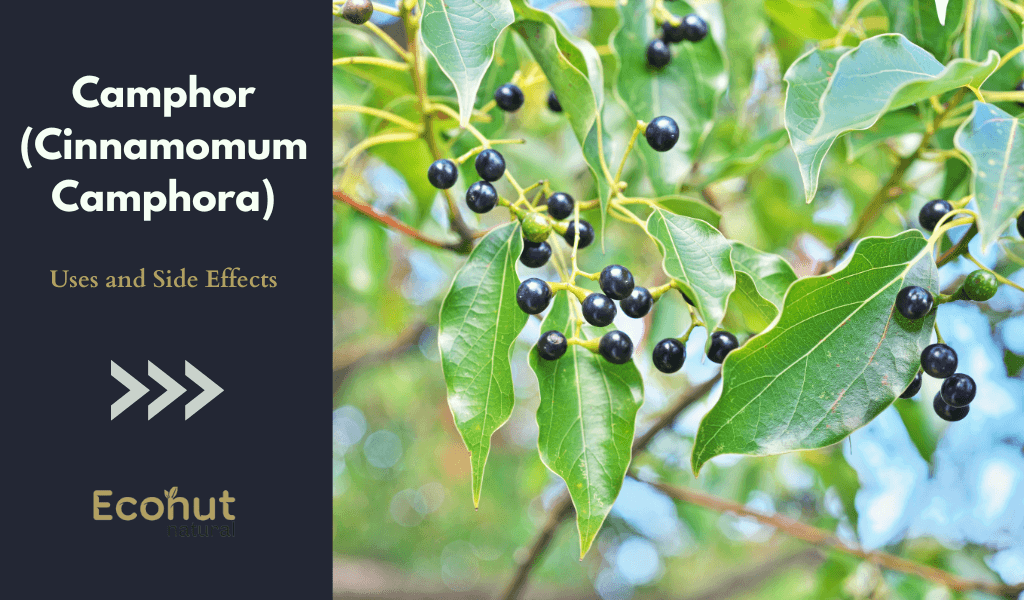Karpura, Camphor (Cinnamomum Camphora) is a white crystalline substance with a strong aroma. It is obtained from the wood of the camphor tree, which is native to East Asia, particularly Japan and China, but also found in other parts of Asia such as Taiwan and India.
Karpura, Camphor (Cinnamomum Camphora) Discription
Karpura, Camphor (Cinnamomum Camphora) is a large evergreen tree native to East Asia, particularly China, Japan, and Taiwan. It belongs to the Lauraceae family and is well-known for its strong aromatic properties.
Appearance:
The camphor tree typically grows up to 20-30 meters tall, with a dense, symmetrical crown. Its bark is rough and grayish-brown when mature, becoming fissured with age. The leaves are glossy, dark green, and alternate, with a leathery texture. They are elliptical to ovate in shape, around 5-15 cm long, and emit a pleasant fragrance when crushed.
Aroma:
The most notable characteristic of the camphor tree is its distinctive aroma. The leaves, bark, and wood all contain volatile compounds that release a strong, fresh, and cooling scent reminiscent of menthol or eucalyptus. This scent is due to the presence of camphor, a white, crystalline substance found in various parts of the tree.
Camphor Crystals:
The camphor tree produces crystals of camphor, which are extracted through a distillation process from the wood, leaves, or roots. These crystals have a sharp, penetrating aroma and are used for various purposes, including medicinal, culinary, and aromatic applications.
Cultural Significance:
In many cultures, the camphor tree holds symbolic significance and is associated with purification, protection, and spiritual practices. Camphor has been used in religious ceremonies, rituals, and as incense for its purifying and aromatic qualities.
Ecological Importance:
In its native habitat, the camphor tree plays a crucial role in the ecosystem, providing habitat and food for various wildlife species. However, it can also become invasive in some regions where it has been introduced, outcompeting native vegetation.
Other Language name of Karpura, Camphor (Cinnamomum Camphora)
Sanskrit name: Karpura
Hindi name: Karpur, karpuram
English Name: Camphor tree, Camphor laurel
Kannada Name: Pache karpoora
Bengali Name: Karpur
Telugu name: Karpooram Chettu
Marathi name: Karpur
Gujarati Name: Karpur
Tamil Name: Karpooram, Pachai Karpooram
Chinese: Xiang-zhang, Zhang-shu
Creole: Kalm, bom zangle
Dutch: Kamferboom
French: camphrier, camphre, baume anglais, Arbre a camphre
German: KampferBaum
Italian: Canfora, confora
Japanese: kkusu-no-ki, kusu-no ki, hon-sho
Napali: Kapur
Portuguese: Alcanforeira
Spanish: Alcanfor
Health Benefits of Karpura, Camphor (Cinnamomum Camphora)
Camphor, derived from the Cinnamomum camphora tree, has been used for centuries for its various benefits. Here, we discuss some of most important benefits of Karpura, Camphor (Cinnamomum Camphora) are below.
For Respiratory Health:
Camphor is often used in decongestant balms and inhalants due to its ability to clear nasal passages and ease respiratory discomfort. Inhaling camphor vapors can help alleviate symptoms of congestion, coughs, and colds.
For Pain Relief:
Camphor is known for its analgesic properties, which can help relieve pain and inflammation. It is often used topically in creams, ointments, and liniments to alleviate muscle aches, joint pain, and minor injuries.
Mental Clarity:
In traditional medicine practices like Ayurveda, camphor is believed to have stimulating effects on the mind, promoting mental clarity, alertness, and concentration. It is often used in aromatherapy for its invigorating scent.
Insect Repellent:
Camphor has a strong aroma that repels insects, making it a natural insecticide. It is commonly used in mothballs and insect repellent products to deter pests like mosquitoes, flies, and moths.
In Skin Care:
When used in moderation and properly diluted, camphor can have benefits for the skin. It is believed to have antipruritic properties, helping to alleviate itching and irritation. However, it should be used cautiously to avoid skin irritation or allergic reactions.
Anti-inflammatory:
Camphor exhibits anti-inflammatory properties, making it useful for reducing swelling and inflammation associated with conditions like arthritis and muscle strains.
Antimicrobial:
Camphor possesses antimicrobial properties that make it effective against certain bacteria and fungi. It is commonly used as an ingredient in topical treatments for skin infections, such as acne and fungal infections.
Other Uses of Karpura, Camphor (Cinnamomum Camphora)
- Reduce thirst and dryness of the mouth
- Use in mouth freshener
- Relieves the bad breath
- Reduce the burning sensation
- For Tackle worm infestation
Karpura, Camphor (Cinnamomum Camphora) Dosage:
125 to 350 mg.
Side effects of Karpura, Camphor (Cinnamomum Camphora)
Camphor, derived from the Cinnamomum camphora tree, has been used for various medicinal and aromatic purposes for centuries. While it can offer benefits when used appropriately, excessive or improper use can lead to adverse effects. Here, we explain some of side effects regarding Camphor.
Respiratory Irritation:
Inhaling camphor fumes or using it in high concentrations can irritate the respiratory tract, leading to symptoms like coughing, wheezing, and shortness of breath. This is especially true for children and individuals with respiratory conditions like asthma.
Nausea and Vomiting:
Ingesting camphor, whether accidentally or intentionally, can cause gastrointestinal distress, including nausea, vomiting, and stomach pain. In severe cases, it can lead to poisoning.
Neurological Effects:
High doses of camphor can affect the central nervous system, leading to symptoms such as confusion, dizziness, headache, and seizures. These effects are more likely to occur with ingestion or excessive absorption through the skin.
Liver Toxicity:
Prolonged or excessive use of camphor can potentially harm the liver. It’s important to use camphor-containing products cautiously and in moderation.
Allergic Reactions:
Some individuals may be allergic to camphor, experiencing symptoms such as itching, hives, or swelling upon exposure.
Drug Interactions:
Camphor may interact with certain medications, either enhancing or reducing their effects. It’s essential to consult a healthcare professional before using camphor products, especially if you are taking medications.
Children and Pregnant Women:
Camphor products should be used with extreme caution in children and pregnant women. Ingestion or excessive exposure to camphor can be particularly dangerous for these groups and may result in severe toxicity.
Skin Irritation:
Direct contact with camphor can cause skin irritation, redness, and even allergic reactions in some individuals. It’s advisable to dilute camphor oil before applying it to the skin to minimize this risk.
Conclusion
Cinnamomum camphora, commonly known as camphor, is a versatile tree renowned for its strong aroma and medicinal properties. With its glossy leaves and distinctive fragrance, it holds cultural significance and has been utilized in various traditional practices for centuries. Extracts from its wood, leaves, and roots yield camphor crystals, valued for their therapeutic benefits in alleviating pain, inflammation, and respiratory ailments. From ancient rituals to modern medicine, the camphor tree continues to captivate with its aromatic allure and healing potential.
FAQS
Is Karpura safe to use?
When used in small quantities and for its intended purposes, Karpura is generally considered safe. However, it can be toxic if ingested in large amounts and can cause irritation or allergic reactions if applied directly to the skin. It should be kept out of reach of children and pets.
Can Karpura be used during pregnancy or breastfeeding?
Pregnant or breastfeeding women should consult their healthcare provider before using Karpura, as there is limited research on its safety during these periods.
Are there any contraindications or interactions with medications?
Karpura may interact with certain medications or exacerbate certain medical conditions. It is important to consult a healthcare professional before using Karpura, especially if you have any pre-existing medical conditions or are taking medications.
Also More: Patala (Stereospermum suaveolens): Uses, Health Benefits and Side Effects

